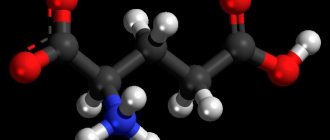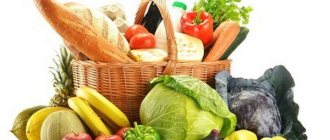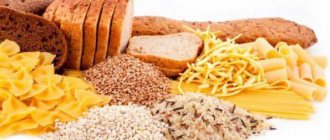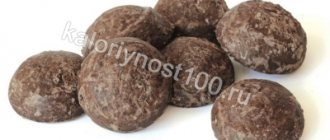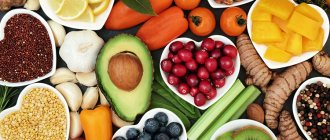Classification of carbohydrates
Carbohydrates are organic substances whose molecules consist of carbon, hydrogen and oxygen atoms, and hydrogen and oxygen are found in them, as a rule, in the same ratio as in a water molecule (2: 1).
However, the name "carbohydrates" has taken root and is now generally accepted for these substances.
Carbohydrates, according to their ability to hydrolyze, can be divided into three main groups: mono-, di- and polysaccharides.
Monosaccharides are carbohydrates that do not hydrolyze (cannot be broken down by water). In turn, depending on the number of carbon atoms, monosaccharides are divided into trioses (the molecules of which contain three carbon atoms), tetroses (four carbon atoms), pentoses (five), hexoses (six), etc.
In nature, monosaccharides are represented mainly by pentoses and hexoses.
Pentoses include, for example, ribose - C5H10O5 and deoxyribose (ribose from which the oxygen atom has been “removed”) - C5H10O4. They are part of RNA and DNA and determine the first part of the names of nucleic acids.
Hexoses with the general molecular formula C6H12O6 include, for example, glucose, fructose, and galactose.
Formula of glucose
1. Sucrose (common table sugar), which upon hydrolysis forms one molecule of glucose and a molecule of fructose. It is found in large quantities in sugar beets, sugar cane (hence the names beet or cane sugar), maple (Canadian pioneers mined maple sugar), sugar palm, corn, etc.
2. Maltose (malt sugar), which hydrolyzes to form two glucose molecules. Maltose can be obtained by hydrolysis of starch under the action of enzymes contained in malt - sprouted, dried and ground barley grains.
3. Lactose (milk sugar), which hydrolyzes to form glucose and galactose molecules. It is found in mammalian milk (up to 4-6%), has low sweetness and is used as a filler in dragees and pharmaceutical tablets.
The sweet taste of different mono- and disaccharides is different. Thus, the sweetest monosaccharide - fructose - is 1.5 times sweeter than glucose, which is taken as the standard. Sucrose (a disaccharide), in turn, is 2 times sweeter than glucose and 4-5 times sweeter than lactose, which is almost tasteless.
Polysaccharides - starch, glycogen, dextrins, cellulose, etc. - carbohydrates that are hydrolyzed to form many monosaccharide molecules, most often glucose.
To derive the formula of polysaccharides, you need to “subtract” a water molecule from a glucose molecule and write down an expression with the index n: (C6H10O5)n, because it is due to the elimination of water molecules that di- and polysaccharides are formed in nature.
The role of carbohydrates in nature and their importance for human life is extremely great. Formed in plant cells as a result of photosynthesis, they act as a source of energy for animal cells. This primarily applies to glucose.
Many carbohydrates (starch, glycogen, sucrose) perform a storage function, the role of a reserve of nutrients.
RNA and DNA acids, which contain some carbohydrates (pentose-ribose and deoxyribose), perform the functions of transmitting hereditary information.
Cellulose, the building material of plant cells, plays the role of a framework for the membranes of these cells. Another polysaccharide, chitin, performs a similar role in the cells of some animals: it forms the external skeleton of arthropods (crustaceans), insects, and arachnids.
Carbohydrates ultimately serve as our source of nutrition: we consume grains, which contain starch, or feed them to animals, in whose bodies the starch is converted into proteins and fats. The most hygienic clothing is made from cellulose or cellulose-based products: cotton and linen, viscose fiber, silk acetate. Wooden houses and furniture are built from the same cellulose that makes up wood.
The production of photographic and film films is based on the same cellulose. Books, newspapers, letters, banknotes are all products of the pulp and paper industry. This means that carbohydrates provide us with everything necessary for life: food, clothing, shelter.
In addition, carbohydrates are involved in the construction of complex proteins, enzymes, and hormones. Carbohydrates also include such vital substances as heparin (it plays a vital role in preventing blood clotting), agar-agar (it is obtained from seaweed and is used in the microbiological and confectionery industries - remember the famous Bird's Milk cake).
Starch content in buckwheat. How many carbohydrates are in buckwheat?
The carbohydrate content in buckwheat is about 70 g per 100 g of dry cereal - however, despite the fact that this is a quite typical figure for most cereals, buckwheat carbohydrates are fundamentally different from rice carbohydrates. Since buckwheat is low in energy, it releases its energy to the body more slowly, without causing a sharp increase in blood sugar and is suitable for diabetics.
Another health benefit of buckwheat is its protein profile. 100 g of cereal before cooking contains about 13 g of protein - which is superior to rice, semolina, wheat, pearl barley and other cereals. In addition, the proteins contained in buckwheat have a complete profile of essential amino acids - this is especially important when following a diet for weight loss or vegetarianism.
Buckwheat also contains phytonutrients - they can influence the synthesis of insulin in the body, normalizing metabolic processes and helping to fight excess weight and type 2 diabetes¹. At the same time, this is the natural state of buckwheat. Unlike brown buckwheat, it is not subjected to preliminary heat treatment (in particular, steaming and frying).
Table comparing buckwheat with other cereals
Let us remember that buckwheat is not a cereal crop at all (like wheat, rice or corn), but, in fact, the seeds of the buckwheat flower. Buckwheat is a pseudocereal, like quinoa and amaranto. At the same time, the key difference between buckwheat is that it does not contain protein, unlike the aforementioned wheat. In addition, buckwheat is rich in natural antioxidants rare for other cereals.
General rules
A carbohydrate diet for weight loss is based on a sharp limitation or complete exclusion of simple carbohydrates from the diet and an increase in foods and dishes from them high in complex carbohydrates with a reduced intake of fat. This dietary program, which seems like a paradox to many, is based on accelerating metabolic , which is due to the relatively rapid absorption of carbohydrates in the body.
The importance of carbohydrates in human nutrition is extremely high. First of all, it is the main source of recycled energy that ensures life. The energy function is performed mainly by glucose, fructose, glycogen, sucrose and starch. An important role is played by “indigestible” carbohydrates (hemicellulose, cellulose, pectin), which stimulate the motor function of the gastrointestinal tract, adsorb cholesterol and toxic compounds, and create conditions for the normal functioning of the natural intestinal microflora.
Carbohydrates are represented by a large class of compounds and include both simple - monosaccharides and complex - polysaccharides . The effect of different types of carbohydrates on metabolism varies significantly.
Simple (quickly digestible) carbohydrates - in the body they are broken down into monosaccharides (glucose and fructose), which are quickly absorbed, and if there is an excess of them in the body and there is no immediate need for them, a complex mechanism of their conversion into subcutaneous and intra-abdominal fat is triggered. This type of carbohydrate quickly increases blood sugar levels, which leads to a feeling of fullness, which goes away just as quickly. These include honey, sugar, confectionery, sweet fruits. Such sources of carbohydrates in the diet must be limited.
Complex (slowly digestible) carbohydrates - starch, pectin, glycogen, inulin, fiber. The structure of the molecule is complex and includes dozens of monosaccharides . The process of their breakdown occurs in the small intestine quite slowly (the duration is 2-5 times longer), and the process of their absorption is slowed down by fiber. They slowly increase blood sugar levels and the body is evenly saturated with energy. It is these carbohydrates in food that should be the main source of energy and account for 95% of the daily value. These include various products containing a lot of fiber, pectin, starch (cereals and cereals made from them, white rice, whole grain bread, bananas, pineapple, grapes, dried fruits and others).
A general idea of the carbohydrate content of certain foods can be obtained from the table below.
Table of carbohydrate content in food:
| Product name | Carbohydrate content (per 100 g of product) |
| White bread | 50 |
| Boiled pasta | 25 |
| Cornflakes | 75 |
| Boiled rice | 30 |
| Armenian lavash | 56 |
| Bagels | 58 |
| Bread Borodinsky | 40 |
| Wheat porridge | 26 |
| Buckwheat | 29 |
| White sugar | 105 |
| Marmalade | 70 |
| Honey | 77 |
| Milk chocolate | 60 |
| Walnuts | 12 |
| Peanut | 15 |
| Cashew | 25 |
| Hazelnut | 15 |
| Sunflower seeds | 18 |
| Sesame seeds | 20 |
| Dates | 68 |
| Watermelon | 9 |
| Eggplant | 5 |
| Green peas | 12 |
| Parsley | 8 |
| Tomatoes | 4 |
| Carrot | 5 |
| Sweet pepper | 5 |
| Boiled potatoes | 16 |
| Boiled beets | 7 |
| Fruit kefir | 5 |
| Whole milk | 12 |
| Sour cream | 3 |
| Milk ice cream | 25 |
| Shortbread cookies | 68 |
| Banana | 20 |
| Grape | 15 |
| Raspberries, strawberries | 5 |
| Tangerines, oranges | 7 |
| Apricot compote | 21 |
| Pear compote | 18 |
| Dried rose hips | 22 |
| Red/black currant | 7 |
| Cherry | 12 |
| Apples | 10 |
This list of products will allow you to create your individual dietary menu for the week every day.
The basic principles of dietary nutrition are:
- Follow your individual “norm” of carbohydrate consumption for weight loss, calculated according to the formula: 3.0 g x 1 kg of weight, proteins are not limited, fats are reduced to 75-80 g/day, mainly due to solid animal fats. The total calorie content is about 1600 - 1800 Kcal/day.
- Eliminate or sharply limit foods containing simple carbohydrates from your diet by increasing complex carbohydrates in your menu. The ratio of complex and simple carbohydrates should be approximately 95 to 5 percent.
- Practice split meals.
- The main intake of foods containing complex carbohydrates should be 1 meal in the first half of the day. At other meals it is necessary to combine proteins with carbohydrates. For dinner, it is recommended to avoid eating carbohydrates, giving preference to protein foods.
- Limit salt intake in your diet.
- Avoid snacking between meals, and if this is difficult for you, exclude flour/confectionery products from the snack menu.
- Prepare dishes using dietary methods - steam, boil, bake, stew.
- Drink at least 1.5 liters of free fluid.



